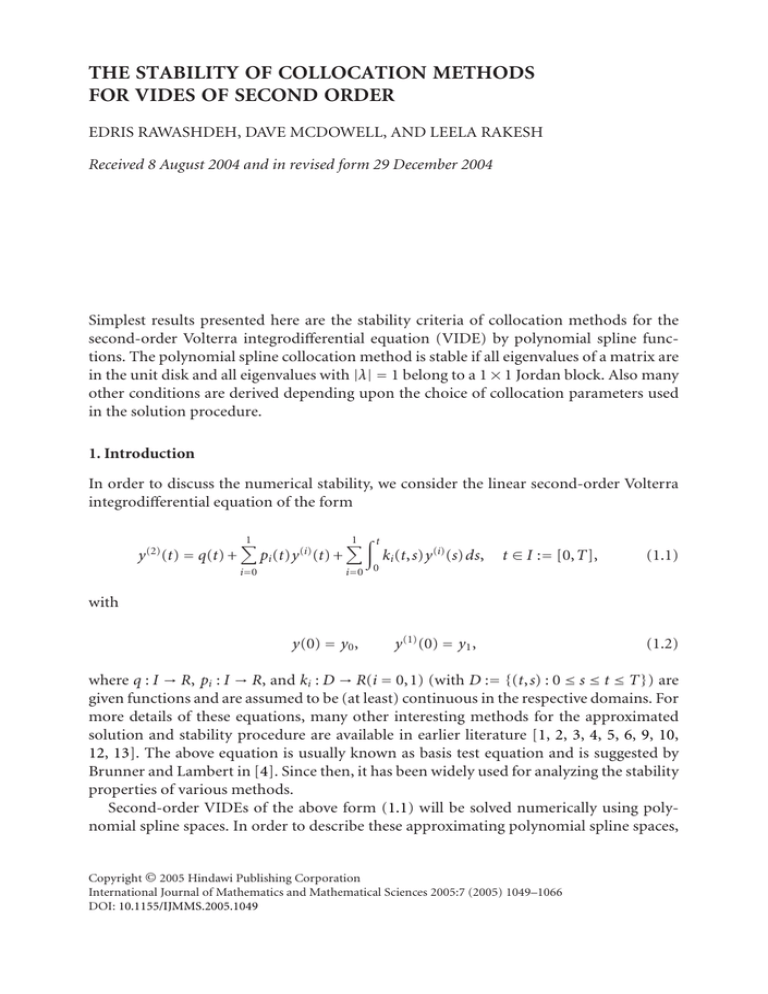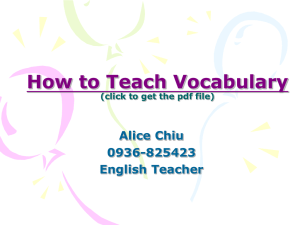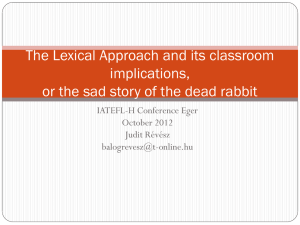THE STABILITY OF COLLOCATION METHODS FOR VIDES OF SECOND ORDER
advertisement

THE STABILITY OF COLLOCATION METHODS
FOR VIDES OF SECOND ORDER
EDRIS RAWASHDEH, DAVE MCDOWELL, AND LEELA RAKESH
Received 8 August 2004 and in revised form 29 December 2004
Simplest results presented here are the stability criteria of collocation methods for the
second-order Volterra integrodifferential equation (VIDE) by polynomial spline functions. The polynomial spline collocation method is stable if all eigenvalues of a matrix are
in the unit disk and all eigenvalues with |λ| = 1 belong to a 1 × 1 Jordan block. Also many
other conditions are derived depending upon the choice of collocation parameters used
in the solution procedure.
1. Introduction
In order to discuss the numerical stability, we consider the linear second-order Volterra
integrodifferential equation of the form
y (2) (t) = q(t) +
1
i =0
pi (t)y (i) (t) +
1 t
i=0 0
ki (t,s)y (i) (s)ds,
t ∈ I := [0,T],
(1.1)
with
y(0) = y0 ,
y (1) (0) = y1 ,
(1.2)
where q : I → R, pi : I → R, and ki : D → R(i = 0,1) (with D := {(t,s) : 0 ≤ s ≤ t ≤ T }) are
given functions and are assumed to be (at least) continuous in the respective domains. For
more details of these equations, many other interesting methods for the approximated
solution and stability procedure are available in earlier literature [1, 2, 3, 4, 5, 6, 9, 10,
12, 13]. The above equation is usually known as basis test equation and is suggested by
Brunner and Lambert in [4]. Since then, it has been widely used for analyzing the stability
properties of various methods.
Second-order VIDEs of the above form (1.1) will be solved numerically using polynomial spline spaces. In order to describe these approximating polynomial spline spaces,
Copyright © 2005 Hindawi Publishing Corporation
International Journal of Mathematics and Mathematical Sciences 2005:7 (2005) 1049–1066
DOI: 10.1155/IJMMS.2005.1049
1050
let
Stability of the collocation methods
N
: 0 = t0 < t1 < · · · < tN = T be the mesh for the interval I, and set
σn := tn ,tn+1 ,
hn := tn+1 − tn ,
n = 0,1,...,N − 1,
h = max hn : 0 ≤ n ≤ N − 1 ,
(mesh diameter),
ZN := tn : n = 1,2,...,N − 1 ,
(1.3)
Z N = ZN ∪ {T }.
Let πm+d be the set of (real) polynomials of degree not exceeding m + d, where m ≥ 1
and d ≥ −1 are given integers. The solution to initial-value problem (1.1) will be approximated by an element u in the polynomial spline space,
S(d)
m+d ZN := u := u(t)|t ∈σn := un (t) ∈ πm+d , n = 0,1,...,N − 1,
( j)
( j) un−1 tn = un tn for j = 0,1,...,d, tn ∈ ZN ;
(1.4)
that is, by a polynomial spline function of degree m + d which possesses the knots ZN
(−1)
and is d times continuously differentiable on I. If d = −1, then the elements of Sm
−1 (ZN )
may have jump discontinuities at the knots ZN . There are many other papers which had
(1)
treated such problem using S(0)
m (ZN ) and Sm (ZN ) [3, 4, 6] polynomial spline spaces.
According to Miculá et al. [11], an element u ∈ S(d)
m+d (ZN ) has the following form (for
all n = 0,1,...,N − 1 and t ∈ σn ):
u(t) = un (t) =
d
u(r)
n−1 tn r!
r =0
where
ur−1 (0) :=
dr
u(t)
dt r
r
t − tn +
m
an,r t − tn
d+r
,
(1.5)
r =1
t =0
= y (r) (0),
r = 0,1,...,d.
(1.6)
From (1.5), we see that the element u ∈ S(d)
m+d (ZN ) is well defined provided that the
coefficients {an,r }r =1,...,m for all n = 0,1,...,N − 1 are known. In order to determine these
coefficients, we consider a set of collocation parameters {c j } j =1,...,m , where 0 < c1 < · · · <
cm ≤ 1, and define the set of collocation points as
X(N) :=
N
−1
Xn ,
with Xn := tn, j := tn + c j hn , j = 1,2,...,m .
(1.7)
n =0
The approximate solution u ∈ S(d)
m+d (ZN ) will be determined by imposing the condition
that u satisfies the initial-value problem (1.1) on X(N) and the initial conditions, that is,
u(2) (t) = q(t) +
1
pi (t)u(i) (t) +
i =0
1 t
i=0 0
ki (t,s)u(i) (s)ds,
∀t ∈ X(N),
(1.8)
with
u(0) = y0 ,
with a uniform mesh sequence {
N },
u(1) (0) = y1
hn = h, for all n = 0,1,...,N − 1.
(1.9)
Edris Rawashdeh et al.
1051
2. Numerical stability
In [7], Danciu studied the numerical stability of the collocation method for first-order
integrodifferential equations. He studied the behavior of the method as applied to the
initial-value problem integrodifferential test equation
y (t) = q(t) + α0 y(t) + ν
t
0
y(s)ds,
ν = 0.
(2.1)
Equation (2.1) has been suggested by Brunner and Lambert in 1974 (see [4]), since then
it has been extensively used as a basis for investigating the stability properties of several
other methods.
In order to discuss the numerical stability for second-order integrodifferential equations, we study the numerical stability of the collocation spline method when applied to
the initial-value problem integrodifferential test equation of the following form:
y (t) = q(t) + α0 y(t) + α1 y (t) + ν
y(0) = y0 ,
t
0
y(s)ds,
ν = 0,
y (0) = y1 ,
(2.2)
(2.3)
where α1 , α2 , and ν are constants, and the given function g : I → R is sufficiently smooth.
For simplicity, we use a polynomial spline collocation method in the space S(d)
m+d (ZN ),
as an (m,d)-method (see [8]).
Definition 2.1. An (m,d)-method is said to be stable if all solutions {u(tn )} remain
bounded, as n → ∞, h → 0 while hn remains fixed.
From (1.5), we observe that the first d + 1 coefficients of the u ∈ S(d)
m+d (ZN ) are determine by the smooth conditions, and then the collocation conditions can be used to
determine the last m coefficients. Thus, for convenience, we introduce the following notations:
ηn := ηn,r
βn := βn,r
u(r)
n−1 (tn ) r
h;
r!
with βn,r := an,r hd+r , n = 0,1,...,N.
with ηn,r :=
r =0,...,d ,
r =1,...,m ,
(2.4)
Using (2.4) in (1.5), for all t := tn + τh ∈ σn , we have the following equation:
u(t) = un tn + τh =
d
r =0
ηn,r τ r +
m
βn,r τ d+r ,
∀τ ∈ (0,1], n = 0,1,...,N.
(2.5)
r =1
By applying the collocation method to test (2.2) for the case d ≥ 2 and using (2.5) we
have the following collocation equation:
V βn = Wηn + h2 Rn ,
∀n = 0,1,...,N − 1,
(2.6)
1052
Stability of the collocation methods
where V is the m × m matrix, W is the m × (d + 1) matrix, and Rn is the m-vector, whose
elements are given by
V j,r := (d + r)(d + r − 1) − α0 h2 c2j − α1 h(d + r)c j −
3
νh c j
h3
α0 h2 c j + ν c2j
2
νh3
c3 cd+r −2 ,
(d + r + 1) j j
if r = 0,
if r = 1,
h3
W j,r := 2 2
α0 h c j + 2α1 hc j + ν c3j
3
h3 3
2
2
α0 h c j + α1 hrc j + ν
c j − r(r − 1) crj −2
r +1
Rn, j
if r = 2,
(2.7)
if 3 ≤ r ≤ d,
q t0, j − q t0
q tn, j − q tn−1,m + un−1 tn−1,m − un−1 tn
:= +α0 un−1 tn − un−1 tn−1,m + α1 un−1 tn − un−1 tn−1,m
1
+νh
un−1 tn−1 + τh dτ
cm
if n = 0,
if n > 0.
By direct differentiation of (2.5) and using the smooth conditions of the approximation u ∈ S(d)
m+d (ZN ), we get a relationship between vector ηn+1 and vectors ηn and βn , as
follows:
ηn+1 = Aηn + Bβn ,
∀n = 0,1,...,N − 1,
(2.8)
where A is the (d + 1) × (d + 1) upper triangular matrix and B is the (d + 1) × m matrix,
whose elements are given by
a j,r
0
:= r
j
if r < j,
if r ≥ j,
d+r
.
b j,r :=
j
(2.9)
For h small enough, the matrix V is invertible since the determinant of V is a
Vandermonde-type determinant for h = 0. Hence from (2.6) and (2.8), we have
ηn+1 = Aηn + BV −1 Wηn + h2 Rn
= A + BV −1 W ηn + h2 BV −1 Rn .
(2.10)
Thus we have the following recurrence relation:
ηn+1 = Mηn + h2 BV −1 Rn ,
(2.11)
M := A + BV −1 W.
(2.12)
where
Edris Rawashdeh et al.
1053
Therefore, we have the following theorem which represents a stability criterion for the
present method. The proof of this theorem is quite similar to the proof given by Danciu
[7] for first-order VIDEs.
Theorem 2.2. An (m,d)-method is stable if and only if all eigenvalues of matrix M = A +
BV −1 W are in the unit disk and all eigenvalues with |λ| = 1 belong to a 1 × 1 Jordan block.
Remark 2.3. Note that the dimension of the matrix M is d + 1. Moreover, if we denote by
M0 the matrix M with h = 0, and by λ(0) and λ the eigenvalues of M0 and M, respectively,
(0)
(0)
then it follows that the matrix M0 has λ(0)
1 = λ2 = λ3 = 1, for m ≥ 1 and d ≥ 2.
3. Applications
In this section, we will investigate the following special cases.
(I) For the case d = 2, the approximation space is S(2)
m+2 (ZN ). From Theorem 2.2 and
Remark 2.3, we have the following theorem.
Theorem 3.1. For every choice of the collocation parameters {c j } j =1,m , an (m,2)-method is
stable for all m ≥ 1.
(II) For the case m = 1, this choice of m corresponds to a classical spline function, that
is, the approximate solution u ∈ S(d)
1+d (ZN ). Using notations from Remark 2.3 (i.e., M0 is
the matrix M with h = 0, and λ(0) and λ are the respective eigenvalues of M0 and M), we
have
λ = λ(0) + O(h).
(3.1)
If c1 ∈ (0,1] is the collocation parameter, then for all d ≥ 1, using the binomial expansion,
we find that for matrix M0 the trace is,
Tr M0 = d + 2 +
1
c1d−1
1 d −1
− 1+
.
c1
(3.2)
As regard the stability of the spline collocation method, we have the following result.
Theorem 3.2. A (1,d)-method is stable if and only if one of the following conditions is true:
(i) d = 2 and c1 ∈ (0,1],
(ii) d = 3 and c1 = 1.
Proof. For the case d = 2, this theorem follows from Theorem 3.1. If d = 3, then the
fourth eigenvalue of M0 is λ(0)
4 = 1 − (2/c1 ) ≤ −1 for c1 ∈ (0,1], and its absolute value
is 1, if and only if c1 = 1. If d ≥ 4, then setting p = d − 1 in (3.2), we have
Tr M0 = p + 3 +
1
1
p − 1+
c1
c1
p
,
(3.3)
so if d > 4 and c1 ∈ (0,1], then
∞ < Tr M0 < − p = −(d − 1).
(3.4)
1054
Stability of the collocation methods
(0)
(0)
(0)
Since Tr(M0 ) = λ(0)
1 + λ2 + · · · + λd+1 < −d + 1, and λ1 = 1, it results that there exists an
(0)
eigenvalue λ(0) whose value is smaller than −1. If d = 4 then from (3.2), λ(0)
4 + λ5 ≤ −4,
(0)
and therefore λ(0)
4 < −1 or λ5 < −1. Thus from Theorem 2.2 we have that, for d ≥ 4, a
(1,d)-method is unstable for any choice of the collocation parameter c1 ∈ (0,1].
(III) For m = 2, we can prove the following result but the proof is the same as in [7].
Theorem 3.3. Let 0 < c1 < c2 ≤ 1 be the collocation parameters, then
(i) a (2,2)-method is stable for every choice of the collocation parameters,
(ii) a (2,3)-method is stable if and only if c1 + c2 ≥ 3/2,
(iii) if c2 = 1, then a (2,d)-method is unstable for all d ≥ 4.
(IV) For the case d = 3, the approximation u ∈ S(3)
m+3 (ZN ) and the dimension of the
(0)
(0)
matrix M0 is 4 and its first p + 1 eigenvalues are λ(0)
1 = λ2 = λ3 = 1. To compute the
fourth eigenvalue, we need the following results. But, first we introduce the following
notations:
m
Sk := Sk c1 ,...,cm =
ci1 ci2 · · · cik ,
for 1 ≤ k ≤ m,
1≤i1 <···<ik ≤m
(3.5)
S0 := S0 (c1 ,...,cm ) = 1,
Sk, j := Sk c1 ,...,c j −1 ,c j+1 ,...,cm ,
for 1 ≤ k ≤ m − 1, 1 ≤ j ≤ m.
Lemma 3.4. Let 0 < c1 < c2 < · · · < cm ≤ 1 be the collocation parameters, then
1
1
..
.
1
c1
c2
..
.
cm
c12
c22
..
.
2
cm
c1i−1
· · · c2i−1
..
..
.
.
i
−1
· · · cm
c1i+1
c2i+1
..
.
i+1
cm
···
c1m m
· · · c2m c j − ck .
.. ..
= Sm−i
.
.
1≤k< j ≤m
m
· · · cm
···
(3.6)
Proof. We will prove the lemma by induction on the dimension of the matrix, starting
with 2 × 2 matrices. For the 2 × 2 matrices, the result is clearly true. For m × m matrices
(m > 2), we define
1
1
..
f (x) := .
1
1
c1
c2
..
.
c12
c22
..
.
cm−1
x
2
cm
−1
x2
c1i−1
· · · c2i−1
..
..
.
.
i−1
· · · cm−1
· · · xi−1
···
c1i+1
c2i+1
..
.
i+1
cm−1
xi+1
···
···
..
.
···
···
.
m cm
−1 m
x c1m
c2m
..
.
(3.7)
Edris Rawashdeh et al.
Note that
1
1
..
.
1
c12
c22
..
.
2
cm
c1
c2
..
.
cm
c1i−1
· · · c2i−1
..
..
.
.
i−1
· · · cm
···
c1m · · · c2m ..
.. = f cm .
.
.
m
· · · cm
c1i+1
c2i+1
..
.
i+1
cm
1055
···
(3.8)
Now, since f (c1 ) = f (c2 ) = · · · = f (cm−1 ) = 0, we have
f (x) = a(x − b)
m
−1
x − ci ,
(3.9)
i=1
where a, b are constants to be determined. By the induction hypothesis, we obtain
a = Sm−1−i c1 ,...,cm−1
−1
m
c j − ck .
(3.10)
k< j
Moreover, from (3.9),
f (0) = a(−1)m c1 c2 · · · cm−1 b.
(3.11)
On the other hand, from the definition of f and by the induction hypothesis, we have
c1
c2
m+1 f (0) = (−1) .
..
cm−1
c12
c22
..
.
2
cm
−1
c1i−1
· · · c2i−1
..
..
.
.
i −1
· · · cm
−1
c1i+1
c2i+1
..
.
i+1
cm
−1
···
..
.
c1m
c2m
..
.
···
m
cm
−1
···
···
..
.
(3.12)
−1
m
c j − ck .
= (−1)m+1 c1 c2 · · · cm−1 Sm−i c1 ,...,cm−1
k< j
Thus, from (3.11) and (3.12), we have
−1
m
−ab = Sm−i c1 ,...,cm−1
c j − ck ,
(3.13)
k< j
and so
f cm = a cm − b
−1
m
cm − ci
i =1
−1
m
c j − ck
= cm Sm−1−i c1 ,...,cm−1
k< j
+ Sm−i c1 ,...,cm−1
−1
m
c j − ck
k< j
(3.14)
−1
m
cm − ci .
i =1
1056
Stability of the collocation methods
However, since
cm Sm−1−i c1 ,... ,cm−1 + Sm−i c1 ,...,cm−1 = Sm−i c1 ,...,cm = Sm−i ,
m
−1
c j − ck
−1
m
cm − ci =
m
i=1
k< j
(3.15)
c j − ck ,
k< j
we have
f cm = Sm−i
m
c j − ck ,
(3.16)
k< j
which proves the lemma.
Remark 3.5. Note that in Lemma 3.4, if i = m, then we have the Vandermonde determinant.
Corollary 3.6. Let V0 be the matrix V with h = 0, d = 3, that is, V0 is the m × m matrix
whose elements are
V0
j,r
:= (r + 3)(r + 2) C r+1
j .
(3.17)
Then, V0−1 is the matrix whose elements are
V0−1
1
(−1)r+ j S2m−1, j Sm−r, j
ck − cl
(k + 2)(k + 3), (3.18)
det V0
l<k,(l,k= j)
k=1,(k=r)
m
r, j
=
where
det V0 =
m
(k + 2)(k + 3)
ck − cl
k =1
l<k
m
S2m .
(3.19)
Proof. From Lemma 3.4, we have
det V0 =
(k + 2)(k + 3)
k =1
ck − cl
S2m .
(3.20)
l<k
Now
−1
V0
Adj V0
,
=
det V0
(3.21)
Edris Rawashdeh et al.
1057
where Adj(V0 ) is the adjoint matrix of V0 , however,
Adj V0
r, j
m
= (−1)r+ j S2m−1, j
1
1
..
.
×
1
1
.
.
.
1
(k + 2)(k + 3)
k=1,(k=r)
c1
c2
..
.
c12
c22
..
.
c j −1
c j+1
..
.
cm
c2j −1
c2j+1
···
..
.
2
cm
..
.
···
···
..
.
···
···
c1r −2
c2r −2
..
.
crj −−12
−2
crj+1
..
.
r
cm−2
c1r
c2r
..
.
···
crj −1
crj+1
···
..
.
r
cm
..
.
···
..
.
···
···
c1m−1 m−1 c2 .. . m−1 c j −1 .
m−1 c j+1 .. . m−1 cm
(3.22)
Again, by Lemma 3.4 and using relations
Sm−1−(r −1) c1 ,...,c j −1 ,c j+1 ,...,cm = Sm−r c1 ,...,c j −1 ,c j+1 ,...,cm = Sm−r, j ,
(3.23)
we have
1
1
..
.
1
1
.
.
.
1
c1
c2
..
.
c12
c22
..
.
···
c j −1
c j+1
..
.
cm
c2j −1
c2j+1
..
.
2
cm
···
···
..
.
···
..
.
···
c1r −2
c2r −2
..
.
r −2
c j −1
−2
crj+1
..
.
r −2
cm
c1r
c2r
..
.
···
crj −1
crj+1
..
.
r
cm
···
···
..
.
···
..
.
···
c1m−1 c2m−1 .. . m
cmj −−11 ck − cl .
= Sm−r, j
−1 l<k,(l,k= j)
cmj+1
.. . m
cm−1 (3.24)
Thus,
V0−1
1
(−1)r+ j S2m−1, j Sm−r, j
ck − cl
(k + 2)(k + 3), (3.25)
det V0
l<k,(l,k= j)
k=1,(k=r)
m
r, j
=
which completes the proof of the corollary.
Now, we can derive a formula for computing the p + 2-eigenvalue of the matrix M0 .
Theorem 3.7. For the case d = 3 and m ≥ 1, the p + 2-eigenvalue of M0 can be computed
by using the following relation:
λ(0)
4 =
Sm − 2Sm−1 + 3Sm−2 + · · · + (−1)m−1 mS1 + (−1)m (m + 1)
.
Sm
(3.26)
1058
Stability of the collocation methods
Proof. Let V0 and W0 be the matrices V and W, respectively, with h = 0, then for d = 3,
W0 is an m × 4 matrix whose elements are given by
W0
0
j,r
if r = 0,1,2,
if r = 3.
:=
−6c j
(3.27)
Now, the fourth eigenvalue of M0 = A + BV0−1 W0 is
λ(0)
4 = 1+
m
(B)4,r V0−1 W0
r,4 .
r =1
(3.28)
From (2.8), the entries of the last row of matrix B are
3+r
(B)4,r =
.
3
(3.29)
Moreover, from (3.27) and Corollary 3.6, we have
−1
V0 W 0
r,4
=
m −6 (−1)(r+ j) S2m−1, j Sm−r, j c j
det V0
j =1
×
ck − cl
l<k,(l,k= j)
m
(3.30)
(k + 2)(k + 3) .
k=1,(k=r)
Therefore,
λ(0)
4
6
= 1+
det V0 r =1 j =1
m m
3+r
(−1)(r+ j+1) S2m−1, j Sm−r, j c j
3
×
ck − cl
l<k,(l,k= j)
m
(3.31)
(k + 2)(k + 3) .
k=1,(k=r)
By using relations
6
3+r
3
c j S2m−1, j = Sm Sm−1, j ,
m
(k + 2)(k + 3) = (r + 1)
m
(3.32)
(k + 2)(k + 3),
k =1
k=1,(k=r)
and det(V0 ), the above expression can be simplified as follows:
m
λ(0)
4
= 1+
r =1 (−1)
r (r
+ 1)
m
j =1 (−1)
Sm
( j+1) S
m−1, j Sm−r, j
l<k
ck − cl
l<k,(l,k= j)
ck − cl
.
(3.33)
Edris Rawashdeh et al.
1059
However, from Lemma 3.4, we have
1
1
m
( j+1)
(−1)
Sm−1, j Sm−r, j
ck − cl = ..
.
j =1
l<k,(l,k= j)
1
= Sm−r
c12
c22
..
.
2
cm
c1
c2
..
.
cm
m
c1r −1
· · · c2r −1
..
..
.
.
r
· · · cm−1
···
c1r+1
c2r+1
..
.
r+1
cm
c1m · · · c2m .. ..
.
.
m
· · · cm
···
ck − cl .
l<k
(3.34)
Hence,
λ(0)
p+2
m
r =1 (−1)
r (r
+ 1)Sm−r
Sm
(−1)r (r + 1)Sm−r
= r =0
Sm
Sm − 2Sm−1 + 3Sm−2 + · · · + (−1)m−1 mS1 + (−1)m (m + 1)
=
,
Sm
= 1+
m
which concludes the proof of Theorem 3.7.
(3.35)
Remark 3.8. Theorem 3.7 proves the conjecture asserted by Danciu [7] for first-order
integrodifferential equations (p = 1,d = 2).
As an application to Theorem 3.7, we can prove the following results. The proofs are
quite similar to [7] for the first-order Volterra integrodifferential equation.
Corollary 3.9. An (m,3)-method is stable if and only if
d/dt t · R (t) m
t =1 ≤ 1,
Rm (0)
(3.36)
where Rm (t) is the polynomial of degree m whose zeroes are the collocation parameters
{c j } j =1,...,m .
Regarding the stability of local superconvergent solution u ∈ S(3)
m+4 (Zn ), we have the
following corollary.
Corollary 3.10. (i) If the collocation parameters {c j } j =1,...,m are uniformly distributed in
(0,1] (i.e., c j = j/m, for all j = 1,2,...,m), then (m,3)-method is stable for m ≥ 1.
(ii) If the collocation parameters {c j } j =1,...,m are the Radau II points in the interval (0,1],
then (m,3)-method is unstable for m ≥ 2.
(iii) If the collocation parameters {c j } j =1,...,m are the Gauss points in the interval (0,1],
then (m,3)-method is unstable for m ≥ 2.
(iv) If the first m − 1 collocation parameters {c j } j =1,...,m are the Gauss points in the interval (0,1) and the last collocation parameter is cm = 1, then (m,3)-method is stable for
m ≥ 2.
1060
Stability of the collocation methods
4. Stability of S(0)
m (Zn )
In this section, we will investigate the stability when d = 0.
From (2.5), the restriction of u ∈ S(0)
m (Zn ) to the subinterval σn is given by
u(t) = un tn + τh = un−1 tn +
m
βn,r τ r ,
for τ ∈ (0,1], n = 0,1,...,N − 1.
(4.1)
r =1
If we denote by un+1 and by u
n+1 the vectors with m elements
un+1 := un tn + c j h
T
u
n+1 := un tn + c j h
j =1,...m ,
T
j =1,...m ,
(4.2)
then from (4.1), we obtain
un+1 = (1,1,...,1)T un−1 tn + Eβn ,
−2 un+1 = h E βn ,
for n = 0,1,...,N − 1,
for n = 0,1,...,N − 1.
(4.3)
(4.4)
Here the matrices E and E are m × m matrices defined by E := (crj ) j,r =1,...,m and E :=
(r(r − 1)crj −2 ) j,r =1,...,m .
In this case, the collocation equation becomes
T
V βn = h2 W un−1 tn ,un−1 tn ,u
n−1 tn
+ h2 R n ,
(4.5)
for n = 0,1...,N − 1, where W is the m × 3 matrix whose elements are
(W ) j,r
νhc j
:= −α1
1
if r = 1,
if r = 2,
if r = 3,
(4.6)
and the matrix V and the vector Rn are defined in (2.6) when d = 0.
Since V = E + O(h), the elimination of βn between (4.4) and (4.5) yields
u
n (tn, j ) = 1 + O(h) un−1 tn + 1 + O(h) un−1 tn
+ O(h)un−1 tn + 1 + O(h) Rn, j ,
for j = 1,2,...,m
(4.7)
(n = 0,1,...,N − 1).
For τ ∈ [0,1], the second derivatives of the approximation u ∈ S(0)
m (Zn ) may be written
in the form
u
n (t + τh) =
m
L j (τ)u
n tn, j ,
for n = 0,1,...,N − 1,
(4.8)
j =1
where
τ − ci
,
L j (τ) :=
c j − ci
j =1,i= j
m
for j = 0,1,...,m,
(4.9)
Edris Rawashdeh et al.
1061
are the Lagrange fundamental polynomials associated with the collocation parameters
{c j } j =1,m . Now, replacing u (tn, j ) in (4.8) with its values given by (4.7), for n = 0,1,...,
N − 1, we obtain
un tn+1 = 1 + O(h)
u
n −1
tn + un−1 tn +
m
L j (1)Rn, j
for j = 1,2,...,m
+ O(h)un−1 tn ,
(4.10)
j =1
(n = 0,1,...,N − 1).
By integrating relation (4.8), for τ ∈ [0,1], and using relation (4.7), we obtain
un tn+1 = h 1 + O(h) u
n−1 tn + 1 + h 1 + O(h) un−1 tn
+ hO(h)un−1 tn + h 1 + O(h)
for j = 1,2,...,m
1
m
0
L j (τ)Rn, j dτ,
(4.11)
j =1
(n = 0,1,...,N − 1).
Integrating (4.8) one more time and using relation (4.7) yields
un tn+1 = h2 1 + O(h) u
n−1 tn + un−1 tn
2
+ h 1 + O(h)
1s
m
0
for j = 1,2,...,m
0
+ 1 + h2 O(h) un−1 tn
L j (τ)Rn, j dτ ds,
(4.12)
j =1
(n = 0,1,...,N − 1).
Equations (4.7), (4.11), and (4.12) together form a system which may be written in the
form
un tn+1 un−1 tn
un tn+1 = M un−1 tn + 1 + O(h) R n
u
un−1 tn
n tn+1
for n = 0,1,...,N − 1,
(4.13)
where
1 + h2 O(h)
M := hO(h)
O(h)
1s
m
h
L j (τ)Rn, j dτ ds
0 0
j =1
1 m
h
L j (τ)Rn, j dτ
.
Rn :=
0
j =1
m
L j (1)Rn, j
2
h2 1 + O(h) h2 1 + O(h)
1 +h 1 + O(h)
h 1 + O(h)
,
1 + O(h)
1 + O(h)
(4.14)
j =1
Equation (4.13) has the same form as (2.11). Since h = 0 implies that the matrix M has eigenvalues λ1 = λ2 = λ3 = 1, we can prove the following theorem.
1062
Stability of the collocation methods
Theorem 4.1. For every choice of the collocation parameters {c j } j =1,...,m , an (m,0)-method
is stable for all m ≥ 1.
5. Stability of S(1)
m+1 (Zn )
In this section, we will investigate the stability when d = 1.
From (2.5), the restriction of u ∈ S(1)
m+1 (Zn ) to the subinterval σn is given by
u(t) = un (t + τh) =un−1 tn + un−1 tn τ +
m
βn,r τ r+1 ,
r =1
(5.1)
for τ ∈ (0,1], n = 0,1,...,N − 1.
In this case, the collocation equation becomes
T
V βn = h2 W un−1 tn ,un−1 tn ,u
n−1 tn
+ h2 R n ,
(5.2)
for n = 0,1...,N − 1, where W is the m × 3 matrix whose elements are
νhcj
νhc j
(W ) j,r := c j h α0 +
2
1
if r = 1,
if r = 2,
(5.3)
if r = 3,
and the matrix V and the vector Rn are defined in (2.6) when d = 1.
Using the same procedure as in Section 4, we can derive the system
un tn+1 un−1 tn
u
t
n n+1 = M un−1 tn + 1 + O(h) R n ,
u
u
n−1 tn
n tn+1
for n = 0,1,...,N − 1,
(5.4)
where
1 + h2 O(h) h2 O(h) h2 1 + O(h)
1 + hO(h) h 1 + O(h)
M := hO(h)
,
O(h)
O(h)
1 + O(h)
1s
m
h
L j (τ)Rn, j dτ ds
0 0
j =1
m
1
h
L
(τ)R
dτ
.
Rn :=
j
n, j
0
j =1
m
L j (1)Rn, j
2
(5.5)
j =1
Equation (5.4) has the same form as (2.11). Since h = 0 implies that the matrix M has eigenvalues λ1 = λ2 = λ3 = 1, we can prove the following theorem.
Edris Rawashdeh et al.
1063
Theorem 5.1. For every choice of the collocation parameters {c j } j =1,...,m , an (m,1)-method
is stable for all m ≥ 1.
6. Numerical examples
The (3,d)-method is tested using the following three examples in the interval [0,1] with
step size h = 0.05. The following notations will be used in the presentation.
e1 := y t1 − u t1 ,
eN/2 := y(0.5) − u(0.5),
eN := y(1) − u(1),
(6.1)
where u ∈ Sd3+d (Zn ) is the approximate solution.
Example 6.1. Consider the following integrodifferential equation of second order:
t
1
1
y (t) = 1 + y(t) +
2
2
0
y (0) = 2,
y(0) = 2,
y(s)ds,
(6.2)
where y(t) = 2et is the exact solution.
Example 6.2. Consider the following integrodifferential equation of second order:
y (t) = q(t) −
t2 y (t) +
16
t
0
t 2 sy (s)ds,
y(0) = 1,
y (0) = 4,
(6.3)
where q(t) is chosen so that y(t) = sin4t is the exact solution.
Example 6.3. Consider the following integrodifferential equation of second order:
y (t) = q(t) + p1 (t)y(t) + p2 (t)y (t) +
t
+
0
2 ts y (s)ds,
y(0) = 2,
t
0
y(s)ds
(6.4)
y (0) = 0,
with
p1 (t) = −t 3 + 2t − 1,
p2 (t) = 1 − 2t 2 ,
(6.5)
where q(t) is chosen so that y(t) = 1 + cost is the exact solution.
(a) If the collocation parameters are uniformly distributed, that is, c1 = 1/3, c2 = 2/3,
and c3 = 1, then we have Tables 6.1, 6.2, and 6.3 corresponding to Examples 6.1,
6.2, and 6.3, respectively.
√
= (4 − 6)/10,
(b) If the collocation
parameters
are
the
Radau
II
points,
that
is,
c
1
√
c2 = (4 + 6)/10, and c3 = 1, then we have Tables 6.4, 6.5, and 6.6 corresponding
to Examples 6.1, 6.2, and 6.3, respectively.
√
(c) If the collocation parameters
are the Gauss points, that is, c1 = (5 − 15)/10, c2 =
√
1/2, and c3 = (5 + 15)/10, then we have Tables 6.7, 6.8, and 6.9 corresponding
to Examples 6.1, 6.2, and 6.3, respectively.
(d) If
the first two collocation
parameters are the Gauss points, that is, c1 = (3 −
√
√
3)/6, c2 = (3 + 3)/6, and c3 = 1, then we have Tables 6.10, 6.11, and 6.12 corresponding to Examples 6.1, 6.2, and 6.3, respectively.
1064
Stability of the collocation methods
Table 6.1. Approximate error for Example 6.1.
d
2
3
4
e1
0
0
0
eN/2
0
1.00 × 10−9
2.40 × 1010
eN
1.00 × 10−7
3.00 × 10−9
1.46 × 1038
Table 6.2. Approximate error for Example 6.2.
d
2
3
4
e1
1.3 × 10−9
3.00 × 10−10
3.00 × 10−10
eN/2
3.32 × 10−4
3.32 × 10−4
4.20 × 1013
eN
2.10 × 10−3
2.11 × 10−3
2.56 × 1041
Table 6.3. Approximate error for Example 6.3.
d
2
3
4
e1
0
1.00 × 10−10
0
eN/2
8.36 × 10−6
8.35 × 10−6
2.02 × 1012
eN
1.04 × 10−3
1.04 × 10−3
1.24 × 1040
Table 6.4. Approximate error for Example 6.1.
d
2
3
4
e1
0
0
0
eN/2
0
7.35 × 10−4
8.02 × 1023
eN
7.00 × 10−9
6.23 × 108
7.81 × 1065
Table 6.5. Approximate error for Example 6.2.
d
2
3
4
e1
1.40 × 10−9
2.00 × 10−10
8.00 × 10−10
eN/2
3.32 × 10−4
4.52 × 10−2
5.61 × 1027
eN
2.1 × 10−3
3.87 × 1010
5.48 × 1069
Table 6.6. Approximate error for Example 6.3.
d
2
3
4
e1
0
1.00 × 10−11
3.00 × 10−10
eN/2
8.36 × 10−6
8.55 × 10−3
2.34 × 1027
eN
1.04 × 10−3
7.34 × 109
2.28 × 1069
From these numerical examples, we observe that a (3, d)-method is stable for d = 2 and
it is unstable for d = 4. In the case d = 3, this method is stable if the collocation parame√
ters are uniformly distributed (i.e., c j := j/3, for j = 1,2,3) as in case a, or c1 = (3 − 3)/6,
Edris Rawashdeh et al.
1065
Table 6.7. Approximate error for Example 6.1.
d
2
3
4
e1
1.55 × 10−6
9.30 × 10−6
1.01 × 10−4
eN/2
2.55 × 10−3
7.84 × 1020
5.42 × 1052
eN
2.46 × 10−2
1.80 × 1056
5.03 × 10116
Table 6.8. Approximate error for Example 6.2.
d
2
3
4
e1
1.6 × 10−9
1.10 × 10−9
9.40 × 10−9
eN/2
3.59 × 10−4
4.19 × 1017
4.80 × 1048
eN
1.00 × 10−4
3.78 × 1053
4.47 × 10112
Table 6.9. Approximate error for Example 6.3.
d
2
3
4
e1
0
0
2.00 × 10−4
eN/2
4.83 × 10−3
3.40 × 1023
9.96 × 1052
eN
3.65 × 10−2
1.44 × 1059
9.40 × 10116
Table 6.10. Approximate error for Example 6.1.
d
2
3
4
e1
1.00 × 10−9
0
0
eN/2
4.00 × 10−9
0
4.45 × 1013
eN
1.20 × 10−8
7.00 × 10−9
5.12 × 1043
Table 6.11. Approximate error for Example 6.2.
d
2
3
4
e1
1.10 × 10−9
6.00 × 10−10
3.00 × 10−10
eN/2
3.32 × 10−4
3.32 × 10−4
5.43 × 1016
eN
2.11 × 10−3
2.11 × 10−3
6.26 × 1046
Table 6.12. Approximate error for Example 6.3.
d
2
3
4
√
e1
0
1.00 × 10−10
1.00 × 10−10
eN/2
8.36 × 10−6
8.36 × 10−6
3.06 × 1015
eN
1.04 × 10−3
1.04 × 10−3
3.54 × 1045
c2 = (3 + 3)/6, and c3 = 1 as in case (d). These examples illustrate the conclusions of
Theorem 5.1.
1066
Stability of the collocation methods
References
[1]
[2]
[3]
[4]
[5]
[6]
[7]
[8]
[9]
[10]
[11]
[12]
[13]
H. Brunner, A survey of recent advances in the numerical treatment of Volterra integral and
integro-differential equations, J. Comput. Appl. Math. 8 (1982), no. 3, 213–229.
, Polynomial spline collocation methods for Volterra integrodifferential equations with
weakly singular kernels, IMA J. Numer. Anal. 6 (1986), no. 2, 221–239.
, The approximate solution of initial-value problems for general Volterra integrodifferential equations, Computing 40 (1988), no. 2, 125–137.
H. Brunner and J. D. Lambert, Stability of numerical methods for Volterra integro-differential
equations, Computing 12 (1974), no. 1, 75–89.
H. Brunner, A. Pedas, and G. Vainikko, Piecewise polynomial collocation methods for linear
Volterra integro-differential equations with weakly singular kernels, SIAM J. Numer. Anal.
39 (2001), no. 3, 957–982.
H. Brunner and P. J. van der Houwen, The Numerical Solution of Volterra Equations, CWI
Monographs, vol. 3, North-Holland Publishing, Amsterdam, 1986.
I. Danciu, Numerical stability of collocation methods for Volterra integro-differential equations,
Rev. Anal. Numér. Théor. Approx. 26 (1997), no. 1-2, 59–74.
M. E. A. El-Tom, On the numerical stability of spline function approximations to solutions
of Volterra integral equations of the second kind, Nordisk Tidskr. Informationsbehandling
(BIT) 14 (1974), 136–143.
A. Goldfine, Taylor series methods for the solution of Volterra integral and integro-differential
equations, Math. Comp. 31 (1977), no. 139, 691–707.
D. Harvey, Global approximations of initial value problems for speical second order ordinary differential equation, M. S. thesis, Dalhousie University, Halifax, Nova Scotia, 1971.
M. Miculá and G. Micula, Sur la résolution numérique des équations intégrales du type de
Volterra de seconde espèce à l’aide des fonctions splines, Studia Univ. Babeş-Bolyai Ser. Math.Mech. 18 (1973), no. 2, 65–68 (French).
T. Lin, Y. Lin, M. Rao, and S. Zhang, Petrov-Galerkin methods for linear Volterra integrodifferential equations, SIAM J. Numer. Anal. 38 (2000), no. 3, 937–963.
V. Volterra, Theory of Functionals and of Integral and Integro-Differential Equations, Dover Publications, New York, 1959.
Edris Rawashdeh: Department of Mathematics, Center for Applied Mathematics and Polymer
Fluid Dynamics, Central Michigan University, Mount Pleasant, MI 48859, USA
E-mail address: edirash@yahoo.com
Dave McDowell: Department of Mathematics, Center for Applied Mathematics and Polymer Fluid
Dynamics, Central Michigan University, Mount Pleasant, MI 48859, USA
E-mail address: mcdow1dg@cmich.edu
Leela Rakesh: Department of Mathematics, Center for Applied Mathematics and Polymer Fluid
Dynamics, Central Michigan University, Mount Pleasant, MI 48859, USA
E-mail address: leela.rakesh@cmich.edu









